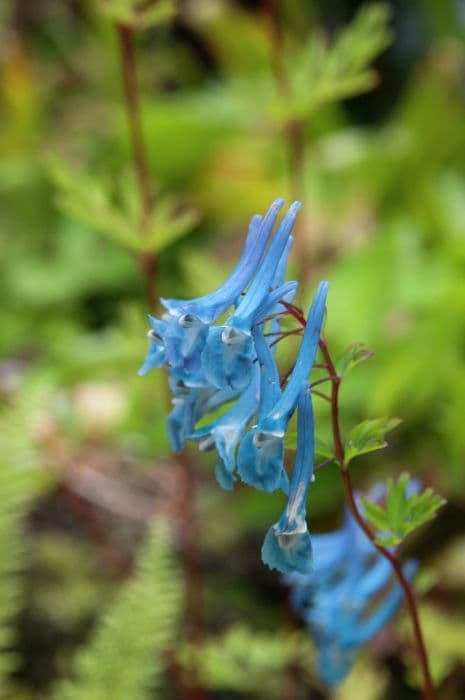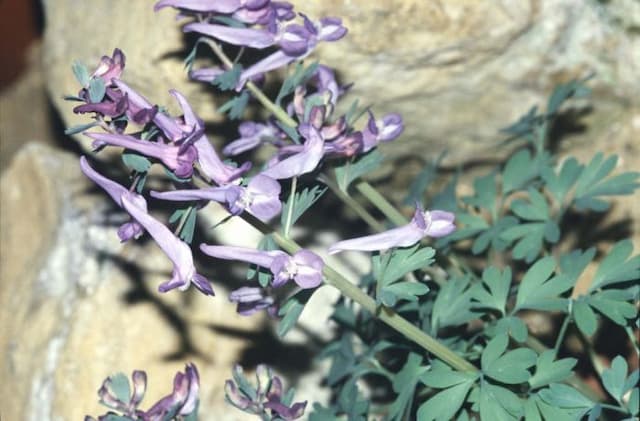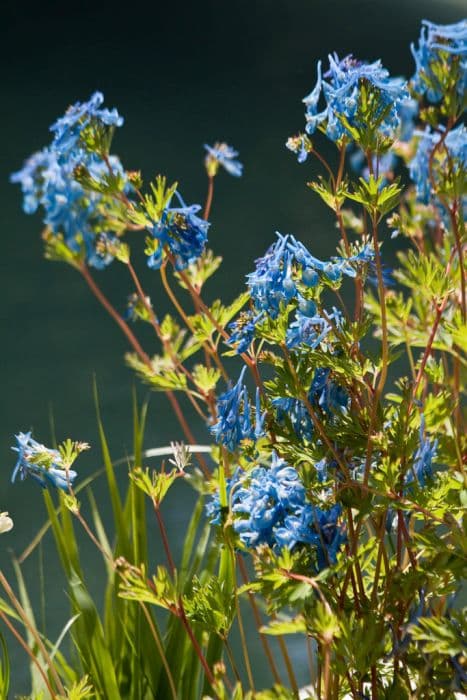Tibetan Blue Poppy Meconopsis quintuplinervia

ABOUT
The plant known most commonly as Tibetan Blue Poppy has a striking appearance, characterized by its beautiful and distinctive blooms. The flowers are a vibrant blue to violet color, often with a hint of purple. Each flower comprises four to six broad petals that emanate from a central core that normally features a cluster of yellow stamens, creating an eye-catching contrast against the blue petals. The foliage of the Tibetan Blue Poppy is equally attractive with its lush green leaves. These leaves are typically elongated and have a somewhat jagged edge, contributing to the plant’s overall lush and textured appearance. The leaves are arranged in a somewhat spiraling pattern around the stem, providing a rich green backdrop for the dramatic blooms. The overall growth pattern of the Tibetan Blue Poppy lends to its allure in gardens and natural settings, as the plant produces an aesthetically pleasing mound of foliage from which the tall flower stalks emerge. Its aesthetic makes it a sought-after plant for ornamental purposes, drawing the eye with its unique coloration and form.
About this plant
 Names
NamesFamily
Papaveraceae
Synonyms
Tibetan Blue Poppy, Five-veined Himalayan Poppy
Common names
Meconopsis quintuplinervia
 Toxicity
ToxicityTo humans
The plant Meconopsis quintuplinervia, commonly known as the blue poppy, has no well-documented toxicity to humans. Therefore, there are no specific symptoms associated with poisoning from this plant. While it is not considered toxic, it’s generally advisable to avoid ingesting any part of ornamental plants due to the potential risks of gastrointestinal discomfort or allergic reactions.
To pets
The blue poppy (Meconopsis quintuplinervia) is not known to be toxic to pets. There are no specific symptoms of poisoning from this plant reported in pets. However, it is always best to prevent pets from eating ornamental plants, as they could potentially cause mild stomach upset or an allergic reaction even if they aren't considered poisonous.
 Characteristics
CharacteristicsLife cycle
Perennials
Foliage type
Deciduous
Color of leaves
Green
Flower color
Varies
Height
1-2 feet (30-60 cm)
Spread
1-2 feet (30-60 cm)
Plant type
Herb
Hardiness zones
5
Native area
China
Benefits
 General Benefits
General Benefits- Aesthetic Appeal: Meconopsis quintuplinervia, commonly known as the Tibetan Blue Poppy, adds striking beauty to gardens with its vibrant blue flowers.
- Biodiversity: The Tibetan Blue Poppy can contribute to biodiversity in gardens by providing a unique species that may attract pollinators.
- Educational Interest: This plant can serve as an interesting subject for botanical studies due to its unique characteristics and mountainous origin.
- Habitat Creation: When planted in gardens, the Tibetan Blue Poppy can create micro-habitats that may be beneficial for small wildlife and insects.
- Cultural Significance: For regions where it is native, such as the Tibetan plateau, this plant has cultural importance and is often featured in art and literature.
- Gardening Challenge: Known for being difficult to cultivate, it can provide a rewarding challenge for experienced gardeners.
- Seasonal Interest: The Tibetan Blue Poppy flowers in spring and can provide an early splash of color after a long winter.
 Medical Properties
Medical Properties- This plant is not used for medical purposes.
 Air-purifying Qualities
Air-purifying QualitiesThis plant is not specifically known for air purifying qualities.
 Other Uses
Other Uses- Artistic Inspiration: The Meconopsis, also known as the Blue Poppy, is often used by artists and photographers for its striking blue color, which adds a vivid accent to visual compositions.
- Educational Tool: Botany educators may use the Blue Poppy to demonstrate plant adaptation and survival in high-altitude ecosystems, as it is native to the Himalayan region.
- Dye Production: Although not commonly used for this purpose, the pigments in the Blue Poppy could potentially be used to create natural dyes for fabrics or art materials.
- Collection and Hobby Gardening: The challenge of growing Blue Poppies, given their specific climate requirements, makes them a prized plant among specialty gardeners and collectors.
- Garden Design: The striking appearance of the Blue Poppy makes it a feature plant in rockeries and alpine garden designs, providing a unique focal point.
- Cultural Symbolism: In certain cultures, the Blue Poppy may be used in garden landscapes to symbolize peace and remembrance due to its color and rare beauty.
- Climate Change Studies: The Blue Poppy can serve as an indicator plant in studies of climate change, as changes in its natural habitat may reflect environmental shifts.
- Culinary Decoration: Although not typically considered an edible plant, the petals of the Blue Poppy could be used to garnish dishes, adding a splash of color for special culinary presentations.
- Gifting and Symbolism: The rarity and distinctive appearance of the Blue Poppy make it a thoughtful gift that can symbolize rarity, beauty, and appreciation for the natural world.
- Sustainable Practices: The cultivation of Blue Poppies can be part of sustainable garden practices that focus on maintaining biodiversity and supporting local ecosystems.
Interesting Facts
 Feng Shui
Feng ShuiThe plant Meconopsis quintuplinervia is not used in Feng Shui practice.
 Zodiac Sign Compitability
Zodiac Sign CompitabilityThe plant Meconopsis quintuplinervia is not used in astrology practice.
 Plant Symbolism
Plant Symbolism- Rarity: Meconopsis quintuplinervia, commonly known as the "Tibetan Blue Poppy," is a rare plant found in the high-altitude regions of Tibet and neighboring areas. It symbolizes uniqueness and rarity due to its limited geographic distribution and the challenges involved in growing it.
- Beauty: With its striking blue petals, the Tibetan Blue Poppy is often associated with sheer beauty and the appreciation of natural wonders. It represents the aesthetic pleasure derived from the natural world.
- Tranquility: The cool blue hue of the Tibetan Blue Poppy is reminiscent of peacefulness and calm, making it a symbol for tranquility and serenity in gardens and art.
- Resilience: Despite its delicate appearance, the Tibetan Blue Poppy grows in harsh mountainous climates, symbolizing the ability to thrive in difficult conditions and resilience in the face of adversity.
- Mystery and Magic: Due to its otherworldly color and remote habitats, the Tibetan Blue Poppy is also seen as a symbol of mystery and is sometimes associated with magical themes in folklore and literature.
 Water
WaterThe Himalayan blue poppy, commonly known as Meconopsis quintuplinervia, should be watered regularly to keep the soil consistently moist but not waterlogged. Typically, watering deeply once a week with about 1 to 2 gallons per plant is sufficient, depending on the climate and soil drainage. In hotter, dryer periods, more frequent watering may be necessary to prevent the soil from drying out, possibly increasing to twice a week. It's important to water the plant at the soil level to avoid getting the foliage wet, which can lead to fungal diseases.
 Light
LightThe Himalayan blue poppy prefers dappled sunlight or part shade, finding the best spot in a garden that mimics its natural woodland environment. It thrives under the protection of taller plants or trees that provide filtered light, protecting it from the intense midday sun. Morning light with afternoon shade is ideal for promoting vigorous growth and flower production.
 Temperature
TemperatureThe Himalayan blue poppy does best in cooler climates, preferring temperatures ranging from 50°F to 70°F. It can tolerate short periods of higher temperatures but consistently hot weather can be detrimental to the plant. The poppy can survive minimum temperatures down to about 20°F; however, prolonged exposure to temperatures below freezing is not advisable. Ideal growing conditions replicate the cool, moist environment of its native Himalayan habitat.
 Pruning
PruningThe Himalayan blue poppy benefits from deadheading spent flowers to encourage additional blooming and to maintain the plant's appearance. Pruning should be done carefully to remove only the dead flower heads and any damaged or dying foliage. This can be done throughout the blooming season. The best time for major pruning is in late winter or early spring, just before new growth begins.
 Cleaning
CleaningAs needed
 Soil
SoilThe Tibetan Blue Poppy prefers a well-draining, humus-rich soil with a slightly acidic to neutral pH of 6.0-7.0. A mix containing equal parts loam, peat moss, and perlite or sand could create an ideal growing medium for this plant.
 Repotting
RepottingTibetan Blue Poppies should be repotted every 1-2 years to replenish soil nutrients and to accommodate growing roots. It's best to repot in early spring before active growth begins.
 Humidity & Misting
Humidity & MistingTibetan Blue Poppies thrive in high humidity environments; maintaining a humidity level of around 60-70% is ideal for these plants.
 Suitable locations
Suitable locationsIndoor
Place in bright, indirect light with cool temperatures.
Outdoor
Choose shaded spot, protect from wind, mulch well.
Hardiness zone
5-7 USDA
 Life cycle
Life cycleMeconopsis quintuplinervia, commonly known as Himalayan Blue Poppy, begins its life cycle when seeds are sown in well-draining soil, ideally under cold conditions, to facilitate germination. Upon germination, seedlings develop into rosettes with a cluster of leaves close to the ground. The plant undergoes vegetative growth, during which it develops a robust root system and foliage. After a period, which may extend beyond a year, Meconopsis quintuplinervia enters the flowering stage, producing its distinctive bright blue to violet flowers, which in some conditions can be short-lived. Following pollination, the flowers develop into fruit capsules containing numerous small seeds. The plant then completes its life cycle as the seeds are dispersed, after which the parent plant may die or enter a period of dormancy before vegetatively growing again if it is a perennial variety.
 Propogation
PropogationPropogation time
Spring-Early Summer
Propogation: Meconopsis quintuplinervia, commonly known as the Himalayan Blue Poppy, is generally propagated through seed sowing. The best time to propagate the Blue Poppy from seeds is during late winter or early spring. To propagate, fill a container with well-drained seed starting mix, sprinkle the tiny seeds on the surface, and lightly cover them with a fine layer of soil. The container should then be placed in a cool location with temperatures around 50°F (10°C) and maintained in moist conditions but not waterlogged. Germination can be erratic and may take several weeks. Once seedlings have developed true leaves, they can be carefully transplanted into individual pots and gradually acclimated to outdoor conditions before planting out in the garden after the risk of frost has passed. This seed sowing process remains the most popular method of propagation for this species due to the complexity of other vegetative propagation methods for this particular genus.









